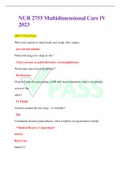Samenvatting
Summary - Molecular therapy (NWI-BM078) 2023/2024
- Vak
- Instelling
- Boek
Extensive summary of the course molecular therapy including pictures, notes on important topics, and possible exam questions mentioned during the lectures . Chapter 15 and 16 from the book Molecular cell biology, Lodish 8th edition are incorporated into the summary. It also includes chapter 4 from ...
[Meer zien]













